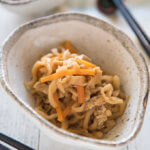
Simmered Kiriboshi Daikon (Shredded Dried Daikon) is a dish of rehydrated dried daikon strips cooked with carrots and aburaage (thin fried tofu) in a lightly flavoured broth. It is a make-ahead dish and one of the very popular side dishes in Japan.
Prep Time includes the time to rehydrate kiroboshi daikon.
Don't forget to see the section 'MEAL IDEAS' below the recipe card! It gives you a list of dishes that I have already posted and this recipe that can make up a complete meal. I hope it is of help to you.
- 60g/2.1oz kiriboshi daikon (note 1)
- 100g/3.5oz carrot (note 2)
- 2 sheets aburaage
- 2 cups boiling water
- 1 tbsp oil
- 400ml/0.8pt dashi stock (note 3)
- 4 tbsp soy sauce
- 2 tbsp mirin
-
Put kiriboshi daikon in a bowl, fill with water and rinse daikon pieces well, changing water a couple of times.
-
Put the washed daikon pieces into a bowl with about 200ml/6.8oz of water and rehydrate for 10 minutes (it expands to 4-5 times in volume). Squeeze water out.
-
Cut carrot into 5cm/2” long, 3mm/⅛" wide match sticks.
-
Pour 2 cups of boiling water over aburaage to remove excess oil, then squeeze water out. Cut the aburaage in half lengthwise, then cut into 5mm/3/16" wide strips crosswise.
-
Heat oil in a saucepan over medium heat. Add carrots and kiriboshi daikon to the suacepan and sauté for 1 minute, untangling the daikon strips.
-
Add aburaage strips and stir. Add the Simmering Broth ingredients to the saucepan, mix and bring it to a boil.
-
Reduce the heat to low, place a drop lid on (note 4) and simmer for about 10-12 minutes until only a small amount of liquid remains (note 5).
-
Serve in a small bowl as an appetiser or mid-size bowl as a side or a warm salad (note 6).
1. Kiriboshi daikon is dried daikon strips. It is sold at Japanese grocery stores. The net weight of my kiriboshi daikon pack was 60g/2.1oz. Please see more details about kiriboshi daikon in the post. You can either buy them at Japanese grocery shops or make at home as per my recipe Home-made Kiriboshi Daikon (Dried Shredded Daikon).
2. I used carrot but you could also add sliced shiitake mushrooms. Make sure that the total weight is 100g/3.5oz.
3. Some recipes utilise the liquid from the rehydrated kiriboshi daikon and mix with dashi stock. It does add a stronger kiriboshi daikon flavour but it lacks the dashi stock flavour. I prefer it without the liquid from the daikon.
If you use knob dash stock, it becomes a vegetarian dish.
4. A drop lid is called ‘otoshi buta’ (落し蓋) in Japanese. It is a round lid that is slightly smaller than the opening of a pot. It is traditionally made of wood but I have a stainless lid as well.
It is placed on top of the ingredients in a pot to ensure the food cooks faster, the heat is evenly distributed, and the ingredients stay in place without breaking apart. It also stops the liquid from evaporating quickly.
If you don’t have a drop lid, you can make one with aluminium foil or baking paper. Cut a square foil/paper, fold/cut the edges to make it a round shape with the diameter slightly smaller than the pot. Then poke the foil/paper with a knife or a chopstick to make holes in several places.
5. Taste test a strip of daikon and see if you need to cook it a bit longer. If the daikon strips become a semi-transparent light brown, then they are usually ready.
6. If you want to add a colour to the dish, you can use blanched snow peas. I sometimes blanch a few snow peas, diagonally slice them thinly and sprinkle them over the Simmered Kiriboshi Daikon.
7. You can freeze Simmered Kiriboshi Daikon. Cool it and drain the liquid using a sieve before storing it in a zip lock bag. Remove air as much as possible and freeze. It can keep up to 1 month. Microwave to defrost and warm up.